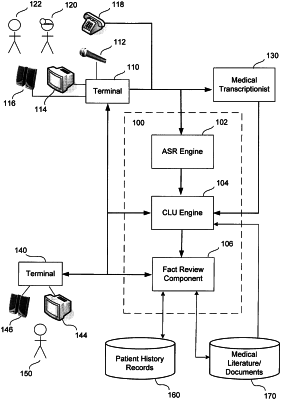| CPC G10L 15/26 (2013.01) [G10L 2015/228 (2013.01)] | 20 Claims |

|
1. A computerized method comprising:
receiving, using a processor, a free-form text documenting a patient encounter provided by a clinician;
automatically extracting, using the processor, a fact containing a clinical term by analyzing a first portion of the free-form text;
receiving an editing of the extracted fact by the clinician;
determining an inconsistency between the free-form text and the editing of the extracted fact;
upon determining the inconsistency, automatically updating, using the processor, a second portion of the free-form text to be consistent with the editing of the extracted fact by the clinician, the second portion of the free-form text being different from the first portion of the free-form text; and
providing, using the processor, a first alert associated with the determined inconsistency to the clinician while the patient encounter is still in progress.
|